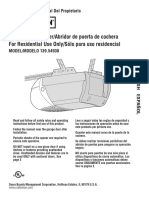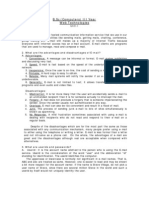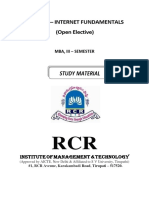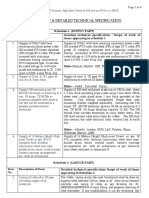Unit 5
Unit 5
Uploaded by
link7096907539Copyright:
Available Formats
Unit 5
Unit 5
Uploaded by
link7096907539Original Title
Copyright
Available Formats
Share this document
Did you find this document useful?
Is this content inappropriate?
Copyright:
Available Formats
Unit 5
Unit 5
Uploaded by
link7096907539Copyright:
Available Formats
ROFEL BBA & BCA College, VAPI
Unit-5
Mail Services
503 NETWORK TECHNOLOGIES
Asst. Prof. Zinkal Patel
ROFEL BBA & BCA COLLEGE VAPI
Unit-5 Mail Services
5.1 Application Layer services:
5.1.1 Concepts of email
5.1.2 Working of email account and services
5.1.3 URL and URL types (Absolute, Relative)
5.2 Case study of email:
5.2.1 From sender to receiver (Mailer, Mail Server, Mailbox)
5.2.2 Functionality and use of protocols at different layers
5.3 Case study of locating Website:
5.3.1 URL and locating URL
5.3.2 Steps and protocols involved in accessing URL
5.3.3 Concepts of search engine and purpose
Application Layer Services
Concept of email
Email is a service which allows us to send the message in electronic mode over the
internet. It offers an efficient, inexpensive and real time mean of distributing
information among people.
E-mail is defined as the transmission of messages on the Internet. It is one of the most
commonly used features over communications networks that may contain text, files,
images, or other attachments. Generally, it is information that is stored on a
computer sent through a network to a specified individual or group of individuals.
Email messages include three components, which are as follows:
o Message envelope: It depicts the email's electronic format.
o Message header: It contains email subject line and sender/recipient information.
o Message body: It comprises images, text, and other file attachments.
Zinkal Patel Page 1
Unit-5 Mail Services
E-Mail Address
Each user of email is assigned a unique name for his email account. This name is
known as E-mail address. Different users can send and receive messages according to
the e-mail address.
E-mail is generally of the form username@domainname. For example,
abcd@gmail.com is an e-mail address where abcd is username and gmail.com is
domain name.
o The username and the domain name are separated by @ (at) symbol.
o E-mail addresses are not case sensitive.
o Spaces are not allowed in e-mail address.
E-mail Message Components
E-mail message comprises of different components: E-mail Header, Greeting, Text,
and Signature. These components are described in the following diagram:
E-mail Header
The first five lines of an E-mail message is called E-mail header. The header part
comprises of following fields:
From
Date
Zinkal Patel Page 2
Unit-5 Mail Services
To
Subject
CC
BCC
From
The From field indicates the sender’s address i.e. who sent the e-mail.
Date
The Date field indicates the date when the e-mail was sent.
To
The To field indicates the recipient’s address i.e. to whom the e-mail is sent.
Subject
The Subject field indicates the purpose of e-mail. It should be precise and to the
point.
CC
CC stands for Carbon copy. It includes those recipient addresses whom we want to
keep informed but not exactly the intended recipient.
BCC
BCC stands for Black Carbon Copy. It is used when we do not want one or more of the
recipients to know that someone else was copied on the message.
Greeting
Greeting is the opening of the actual message. Eg. Hi Sir or Hi Guys etc.
Text
It represents the actual content of the message.
Signature
This is the final part of an e-mail message. It includes Name of Sender, Address, and
Contact Number.
Zinkal Patel Page 3
Unit-5 Mail Services
Advantages:
1. Reliable
Many of the mail systems notify the sender if e-mail message was undeliverable.
2. Convenience
There is no requirement of stationary and stamps. One does not have to go to post
office. But all these things are not required for sending or receiving an e mail.
3. Speed
E-mail is very fast. However, the speed also depends upon the underlying network.
4. Inexpensive
The cost of sending e-mail is very low.
5. Printable
It is easy to obtain a hardcopy of an e-mail. Also an electronic copy of an e-mail
can also be saved for records.
6. Global
E-mail can be sent and received by a person sitting across the globe.
7. Generality
It is also possible to send graphics, programs and sounds with an e-mail.
Disadvantages:
1. Forgery
E-mail doesn’t prevent from forgery, that is, someone impersonating the sender,
since sender is usually not authenticated in any way.
2. Overload
Convenience of E-mail may result in a flood of mail.
Zinkal Patel Page 4
Unit-5 Mail Services
3. Misdirection
It is possible that you may send e-mail to an unintended recipient.
4. Junk
Junk emails are undesirable and inappropriate emails. Junk emails are sometimes
referred to as spam.
5. No Response
It may be frustrating when the recipient does not read the e-mail and respond on a
regular basis.
Working of email account and services
E-mail system comprises of the following three components:
Mailer
Mail Server
Mailbox
1. Mailer
It is also called mail program, mail application or mail client. It allows us to manage,
read and compose e-mail.
2. Mail Server
The function of mail server is to receive, store and deliver the email. It is must for mail
servers to be running all the time because if it crashes or is down, email can be lost.
3. Mailboxes
Mailbox is generally a folder that contains emails and information about them.
Zinkal Patel Page 5
Unit-5 Mail Services
Working of E-mail
Email working follows the client server approach. In this client is the mailer i.e. the
mail application or mail program and server is a device that manages emails.
Following example will take you through the basic steps involved in sending and
receiving emails and will give you a better understanding of working of email system:
o Suppose person A wants to send an email message to person B.
o Person A composes the messages using a mailer program(MUA – Mail User
Agent) i.e. mail client and then select Send option.
o MUA push the mail using Simple Mail Transfer Protocol to sender mail server.
o For example : Suppose person A’s mail address is abc@gmail.com and send
mail to Person B’s mail id xyz@yahoo.com. So mail first push to sender mail
server that is gmail server.
o That mail received by MSA (Mail submission Agent) at person A’s mail server
and then send to MTA(Mail Transmission Agent) using Simple Mail Transfer
Protocol.
o MSA and MTA are type of software installed at server. MSA is used to check
error(mail id is correct or not etc.) in mail.
o The message is routed to Simple Mail Transfer Protocol to MTA at person B’s
mail server.
o Then MTA at receiver side send mail to MDA (Mail Delivery Agent) using SMTP
protocol and MDA store that mail to mailbox.
o Now, to read mail, MUA at receiver side use Post Office protocol version
3(POP3) or Internet Message Access Protocol (IMAP).
o This message is now stored on person B’s PC.
The following diagram gives pictorial representation of the steps discussed above:
Zinkal Patel Page 6
Unit-5 Mail Services
URL and URL types (Absolute, Relative)
URL stands for Uniform Resource Locator. Any internet location available on server
is called a web URL, web address or website.
Each website or webpage has a unique address called URL.
type: It specifies the type of the server in which the file is located.
address: It specifies the address or location of the internet server.
path: It specifies the location of the file on the internet server.
Types of URL: URL gives the address of files created for webpages or other
documents like an image, pdf for a doc file, etc.
There are two types of URL:
Absolute URL
Relative URL
Absolute URL: This type of URL contains both the domain name and directory/page
path. An absolute URL gives complete location information. It begins with a protocol
like “http://” and continues, including every detail.
Zinkal Patel Page 7
Unit-5 Mail Services
Relative URL: This type of URL contains the path excluding the domain name.
Relative means “in relation to”, and a relative URL tells a URL location on terms of
the current location. Relative path is used for reference to a given link of a file that
exist within the same domain.
For example, /images/img.jpg is telling the browser to go to the domain, then look
for the images folder, then find the img.jpg file inside the images folder. If you
update your domain your /images/img.jpg link does not need to be updated.
Concepts of search engine and purpose
Search Engine refers to a huge database of internet resources such as web pages,
newsgroups, programs, images etc. It helps to locate information on World Wide
Web.
User can search for any information by passing query in form of keywords. It then
searches for relevant information in its database and return to the user.
Search Engine Components
Generally there are three basic components of a search engine as listed below:
o Web Crawler
o Database
o Search Interfaces
Web crawler: It is a software component that traverses the web to gather
Information.
Database: All the information on the web is stored in database. It consists of huge
web resources.
Zinkal Patel Page 8
Unit-5 Mail Services
Search Interfaces: This component is an interface between user and the database. It
helps the user to search through the database.
Search Engine Working
Web crawler, database and the search interface are the major component of a search
engine that actually makes search engine to work. Search engines make use of
Boolean expression AND, OR, NOT to restrict and widen the results of a search.
Following are the steps that are performed by the search engine:
The search engine looks for the keyword in the index for predefined database instead
of going directly to the web to search for the keyword.
It then uses software to search for the information in the database. This software
component is known as web crawler.
Once web crawler finds the pages, the search engine then shows the relevant web
pages as a result. These retrieved web pages generally include title of page, size of
text portion, first several sentences etc.
User can click on any of the search results to open it.
These search criteria may vary from one search engine to the other. The retrieved
information is ranked according to various factors such as frequency of keywords,
relevancy of information, links etc.
Examples
Following are the several search engines available today:
Google: It was originally called BackRub. It is the most popular search engine globally.
Bing: It was launched in 2009 by Microsoft. It is the latest web-based search engine
that also delivers Yahoo’s results.
Zinkal Patel Page 9
Unit-5 Mail Services
Ask: It was launched in 1996 and was originally known as Ask Jeeves. It includes
support for match, dictionary, and conversation question.
AltaVista: It was launched by Digital Equipment Corporation in 1995. Since 2003, it is
powered by Yahoo technology.
AOL: It is powered by Google.
Meta Search Engine
A Meta-Search Engine (MSE) means instead of getting results from one search engine,
one will be getting the best combined results from a variety of engines and not just
any engines, but industry-leading engines such as Google, Yahoo! Search, and Bing.
Upon considering each existing search engine, a document or data that a MSE engine
can access are known as a “component” of that MSE. A meta-search may behave in a
similar fashion like any other typical search engine. A list of search-result record are
most relevant with the query will be displayed.
When user querying, the MSE forwards the query to the appropriate component of
search engines through their search interfaces.
When the contents related to the query are retrieved from all the individual search
engines then the results are reorganized into a single list and then returned back to
the user.
Zinkal Patel Page 10
Unit-5 Mail Services
The advantage of MSE is that they are able to "communicate" to other search
engines, which contain relevant data. The language that they speak is HTML (Hyper
Text Markup Language), a set of codes which enables computers to read, translate,
transmit, and store data which is accessible to the entire world. Every Web page is
written in HTML using "tags".
Zinkal Patel Page 11
You might also like
- Teves MK 20 Service Manual PDFDocument78 pagesTeves MK 20 Service Manual PDFColin RobertsNo ratings yet
- Pr-6000-E Auto Pilot Operator's ManualDocument86 pagesPr-6000-E Auto Pilot Operator's ManualClarence Clar100% (2)
- Craftsman 54930 Manual PDFDocument76 pagesCraftsman 54930 Manual PDFcsakagucNo ratings yet
- SSS301 - SSSV301 Assignment 2 2021Document6 pagesSSS301 - SSSV301 Assignment 2 2021Natasha CecilNo ratings yet
- Lecture 11 Electronic Mail OverviewDocument44 pagesLecture 11 Electronic Mail OverviewDJEFOUO FOUODJI ANGE MAGLOIRE100% (1)
- afiusdiufhsiDocument17 pagesafiusdiufhsiFaraz ShahNo ratings yet
- 503 UNIT 5 Mail Services 1Document22 pages503 UNIT 5 Mail Services 1B68- Falguni shrimaliNo ratings yet
- The Question ArDocument10 pagesThe Question Arhwx8nckbnqNo ratings yet
- How Email Works PDFDocument10 pagesHow Email Works PDFKavya AmmuNo ratings yet
- 5.1 Internet Services: Internet Services Allows Us To Access Huge Amount of Information Such As Text, Graphics, SoundDocument21 pages5.1 Internet Services: Internet Services Allows Us To Access Huge Amount of Information Such As Text, Graphics, SoundLydia AllwinNo ratings yet
- Internet: Network (ARPANET) - ARPANET Was Developed by United States Department of DefenseDocument10 pagesInternet: Network (ARPANET) - ARPANET Was Developed by United States Department of Defenseanon_137376969No ratings yet
- It Unit4Document13 pagesIt Unit4rogithaNo ratings yet
- Electronic Mail (E-Mail) Is One of Most Widely Used Services of Internet. This Service AllowsDocument4 pagesElectronic Mail (E-Mail) Is One of Most Widely Used Services of Internet. This Service AllowsLalitha PonnamNo ratings yet
- Unit 5 Client - Server Model & Network SecurityDocument18 pagesUnit 5 Client - Server Model & Network Securityall thinks waseNo ratings yet
- What Is E-Mail?Document15 pagesWhat Is E-Mail?uoksajith_639482650No ratings yet
- CHAPTER 11: Electronic Mail Basics: ObjectivesDocument8 pagesCHAPTER 11: Electronic Mail Basics: ObjectivesddawNo ratings yet
- Email Server FAQ - Part OneDocument16 pagesEmail Server FAQ - Part OnesubhamayNo ratings yet
- Web Technologies Unit-IDocument15 pagesWeb Technologies Unit-Ikprasanth_mcaNo ratings yet
- Ch-7 EmailDocument20 pagesCh-7 EmailMillo NovinNo ratings yet
- Email HackingDocument96 pagesEmail HackingGhanshyam SainiNo ratings yet
- Casestudy 3rdIA Mail ArchitectureDocument8 pagesCasestudy 3rdIA Mail ArchitectureARYA MURALI ECE-2020-24No ratings yet
- InternetDocument11 pagesInternetkamyabconsultants1No ratings yet
- Meeting 11 E-Mail: Electronic Mail, Often Abbreviated As Email, Email, or Email, Is Any Method ofDocument11 pagesMeeting 11 E-Mail: Electronic Mail, Often Abbreviated As Email, Email, or Email, Is Any Method ofArif FadilahNo ratings yet
- IIA Unit 2Document15 pagesIIA Unit 2ssascw.bcaNo ratings yet
- U1l8 EmailDocument3 pagesU1l8 Emailapi-269944580No ratings yet
- Internet Technologies in Depth The Technique of Spam Recognition Based On Header InvestigatingDocument4 pagesInternet Technologies in Depth The Technique of Spam Recognition Based On Header InvestigatingayoubNo ratings yet
- Week 5 - Email ForensicsDocument8 pagesWeek 5 - Email Forensicsmosesd154No ratings yet
- Handling Email in PHPDocument12 pagesHandling Email in PHPSandeep Venupure100% (1)
- Electronic MailDocument7 pagesElectronic Mailسعد سعيدNo ratings yet
- Mail ServicesDocument40 pagesMail Servicesk3112724No ratings yet
- L5 - Electronic CommunicationDocument14 pagesL5 - Electronic Communicationazzehhamzeh360No ratings yet
- Kuvempu University: E-Mail ConceptsDocument28 pagesKuvempu University: E-Mail ConceptsSharath KumarNo ratings yet
- How Emails WorkDocument4 pagesHow Emails WorkSAFA's CreationNo ratings yet
- A Practical Study of E-Mail Communication ThroughDocument21 pagesA Practical Study of E-Mail Communication Throughbared12659No ratings yet
- EmailDocument9 pagesEmailBDlive. LandNo ratings yet
- EMAILDocument9 pagesEMAILspartansheikNo ratings yet
- LECTURE 03 EmailDocument25 pagesLECTURE 03 EmailjosiamazulaNo ratings yet
- U1l8 Email BmaDocument3 pagesU1l8 Email Bmaapi-296920411No ratings yet
- ICF-9-week-1-2 - Q2Document13 pagesICF-9-week-1-2 - Q2Anna May BuitizonNo ratings yet
- Untitled documentDocument2 pagesUntitled documentsuryaravichandran16No ratings yet
- Practical-1 Email Investigation and IP Tracing: HistoryDocument8 pagesPractical-1 Email Investigation and IP Tracing: Historydashrath singhNo ratings yet
- DC 6 PDFDocument8 pagesDC 6 PDFZain Alabeeden AlarejiNo ratings yet
- Phishing Analysis-1Document13 pagesPhishing Analysis-1Uddesh PätilNo ratings yet
- Purp Com FinalsDocument10 pagesPurp Com FinalsRaW sTaRNo ratings yet
- CN WK 16 Lec 31 32Document12 pagesCN WK 16 Lec 31 32noreencosmetics45No ratings yet
- All AboutDocument14 pagesAll Aboutakankshabhardwaj111No ratings yet
- EmailDocument25 pagesEmaildeswalmukesh1No ratings yet
- Lesson 8-EmailDocument4 pagesLesson 8-Emailapi-270386115No ratings yet
- UNIT-2 Part2Document12 pagesUNIT-2 Part2MOHD NAZIM - 33 HBTUNo ratings yet
- Unit 2 Internet Tools: E-Mail, FTP and TelnetDocument24 pagesUnit 2 Internet Tools: E-Mail, FTP and TelnetsamsungloverNo ratings yet
- E - MailDocument12 pagesE - Mailsullivan583No ratings yet
- E - Mail and InternetDocument18 pagesE - Mail and InternetNancyNo ratings yet
- Partially Qualified AddressesDocument5 pagesPartially Qualified AddressesLovekesh BhagatNo ratings yet
- E-Mail ServerDocument32 pagesE-Mail ServerMehari TemesgenNo ratings yet
- Chapter 1 Introduction A.BackgroundDocument6 pagesChapter 1 Introduction A.BackgroundFluxNo ratings yet
- Downloaded File 1732375562137Document8 pagesDownloaded File 1732375562137tcrea76No ratings yet
- Part 8 - EmailDocument29 pagesPart 8 - EmailCharish CabeltesNo ratings yet
- Email and Its DetailDocument27 pagesEmail and Its Detailpoojadevi09112003No ratings yet
- IT221 T Project Template - 1444Document9 pagesIT221 T Project Template - 1444Rr rNo ratings yet
- OnlineDocument32 pagesOnlinesaranyaNo ratings yet
- Final Email ForensicsDocument33 pagesFinal Email Forensicshk5378cbrnNo ratings yet
- 306 Internet FundamentalsDocument86 pages306 Internet FundamentalsMycareer RamNo ratings yet
- Chapter 4 Email ForensicsDocument18 pagesChapter 4 Email ForensicsKrishn kumarNo ratings yet
- Combined Cycle Power PlantDocument29 pagesCombined Cycle Power Plantrajib0403050cuet100% (1)
- E31321en SamsonDocument14 pagesE31321en SamsonÁlvaro HernándezNo ratings yet
- SP Siswati HLDocument100 pagesSP Siswati HLntandoncongwane2006No ratings yet
- Resume T.KanthavelDocument3 pagesResume T.KanthavelKANTHAVEL TNo ratings yet
- Dexterity TestDocument15 pagesDexterity Testaqsa imranNo ratings yet
- ReleaseNote - FileList of X64W11 - 22H2 - SWP - K3704VA - 05.00Document7 pagesReleaseNote - FileList of X64W11 - 22H2 - SWP - K3704VA - 05.00MickaelNo ratings yet
- International AuditDocument27 pagesInternational AuditVitelariu LeonardNo ratings yet
- Mr. Edward S. Choi, Jr. - 5b0faf6f 247d 4e3e 84bc 5c47d27c557fDocument2 pagesMr. Edward S. Choi, Jr. - 5b0faf6f 247d 4e3e 84bc 5c47d27c557fEdward Jr. ChoiNo ratings yet
- Development of A General Thermal Oil Reservoir Simulator (Tesis)Document252 pagesDevelopment of A General Thermal Oil Reservoir Simulator (Tesis)Nacho TorresNo ratings yet
- 1737145-PentagonSpace Resume Format (JAVA)Document2 pages1737145-PentagonSpace Resume Format (JAVA)Santosh TiparashiNo ratings yet
- GSM F017 - Prototype Samples Submission FormDocument5 pagesGSM F017 - Prototype Samples Submission FormQMSNo ratings yet
- Formato InglesDocument4 pagesFormato InglesJhoselin CastilloNo ratings yet
- Resume: Milind Dattatray ShelarDocument4 pagesResume: Milind Dattatray ShelarAnkit MorajkarNo ratings yet
- Algorithms & Data Structures (M) Tutorial ExercisesDocument9 pagesAlgorithms & Data Structures (M) Tutorial Exerciseserica jayasunderaNo ratings yet
- 2.0 Best Practice - FurnaceDocument32 pages2.0 Best Practice - Furnaceramu100% (1)
- Download Complete Merrill s Atlas of Radiographic Positions and Radiologic Procedures Vol 1 10th Edition Philip W. Ballinger Phd Rt(R) Faers Fasrt PDF for All ChaptersDocument75 pagesDownload Complete Merrill s Atlas of Radiographic Positions and Radiologic Procedures Vol 1 10th Edition Philip W. Ballinger Phd Rt(R) Faers Fasrt PDF for All Chaptersnashzladwa100% (5)
- Bit LogicDocument20 pagesBit LogicTracktor7 TracktordesaNo ratings yet
- Empower 3 Enterprise or Workgroup Software For ServersDocument52 pagesEmpower 3 Enterprise or Workgroup Software For ServersMohamed Sallam100% (4)
- Pompa Grease Trap 326,16 LPM @13,2mDocument1 pagePompa Grease Trap 326,16 LPM @13,2mAndreas B KresnawanNo ratings yet
- Rotary Valve SpecificationDocument2 pagesRotary Valve SpecificationRafael CarmoNo ratings yet
- Marca Modelo Ubicacion InfoDocument42 pagesMarca Modelo Ubicacion InfoGabriel GriecoNo ratings yet
- Eged 113 Lesson 1Document13 pagesEged 113 Lesson 1Rubymae OrejudosNo ratings yet
- CS1311A Lecture 4 - Computer SoftwareDocument39 pagesCS1311A Lecture 4 - Computer SoftwareMalefu BelemeNo ratings yet
- Lexical Analysis All Token List and DiffenceDocument4 pagesLexical Analysis All Token List and DiffencedopindermailNo ratings yet
- 02 Modul 1 Pengantar GIS Untuk KesehatanDocument75 pages02 Modul 1 Pengantar GIS Untuk KesehatanRyan JuliansyahNo ratings yet
- Scope of Work & Detailed Technical SpecificationDocument9 pagesScope of Work & Detailed Technical SpecificationBoson FreelancerNo ratings yet

























































































